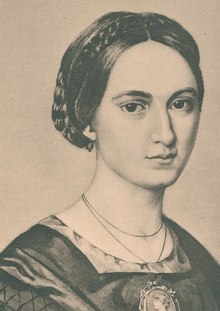Milica Stojadinović-Srpkinja | |
|---|---|
 Portrait of poet Milica Stojadinović-Srpkinja | |
| Born | 6 July 1828 |
| Died | 25 July 1878 (aged 50)[1] |
| Occupation | Poet |
Milica Stojadinovic-Srpkinja (Serbian Cyrillic: Милица Стојадиновић Српкиња, pronounced [mîlitsa stɔjadǐːnɔv̞itɕ sr̩̂pkiɲa]) (1828–1878) was a Serbian poet, sometimes called "the greatest female Serbian poet of the 19th century".
Career[edit]
As her fame spread beyond the confines of Serbian culture of the Austrian Empire, Prince Mihailo Obrenović would invite her to court when she came to Belgrade and Vienna-based anthropologist and poet Johann Gabriel Seidl devoted a poem to her.
She corresponded extensively with writers Đorđe Rajković (1825–1886), Ljubomir Nenadović, Vuk Stefanović Karadžić and his daughter Wilhelmine/Mina, Božena Němcová, and with Ludwig August von Frankl. In 1891 an almanach Die Dioskuren was issued in Vienna by Ludwig von Frankl with a collection of letters written by Milica Stojadinović.
Reception[edit]

Her work, though, has been mostly out of the public eye and almost forgotten except by literary experts for most of the 20th century, first during fin-de-siècle modernist poeticism as an outdated poetic form of pre-1870s, and later, under Communist rule as an unacceptable expression of patriotism for only one of the six nations of Yugoslavia (namely: Serbian).[citation needed]
After Josip Broz Tito's death the awareness of her work was revived, and in the last quarter of a century a four-day poetry memorial is convened annually in Novi Sad in her honour, where a poetry prize bearing her name is awarded to prominent poets from Serbia.
Biljana Dojčinović has written on the role of Stojadinović-Srpkinja in the development of women's writing in Serbia, through a feminist framework.[2]
See also[edit]
Notes[edit]
References[edit]
- ^ Božidar Kovaček (1971). Živan Milisavac (ed.). Jugoslovenski književni leksikon [Yugoslav Literary Lexicon] (in Serbo-Croatian). Novi Sad (SAP Vojvodina, SR Serbia): Matica srpska. p. 510.
- ^ Cornis-Pope, Marcel; Neubauer, John (2010-09-29). History of the Literary Cultures of East-Central Europe: Junctures and disjunctures in the 19th and 20th centuries. Volume IV: Types and stereotypes. John Benjamins Publishing. p. 154. ISBN 978-90-272-8786-1.
- Jovan Skerlić, Istorija Nove Srpske Književnosti / History of Modern Serbian Literature (Belgrade, 1914, 1921), p. 208. Her biography was translated from Skerlić's Serbian into English for this entry in the Wikipedia.

Well, that’s interesting to know that Psilotum nudum are known as whisk ferns. Psilotum nudum is the commoner species of the two. While the P. flaccidum is a rare species and is found in the tropical islands. Both the species are usually epiphytic in habit and grow upon tree ferns. These species may also be terrestrial and grow in humus or in the crevices of the rocks.
View the detailed Guide of Psilotum nudum: Detailed Study Of Psilotum Nudum (Whisk Fern), Classification, Anatomy, Reproduction